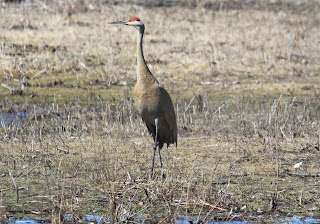NATURE NOTES
NATURE NOTES OF S.E. MINNESOTA
Tuesday, April 23, 2013
Monday, April 15, 2013
RUBY-CROWNED KINGLETS
The Ruby-Crowned Kinglet is a very small insect hunter. Note the "ruby" color on its crown. It has a first cousin called the Golden-Crowned Kinglet-don't have a picture yet of that one. We often hear their high pitched call before we see them. They will soon head to far northern Minnesota and Canada to breed.
LINKS YOU MAY LIKE TO TRY
minnesotawildflowers.infominnesotawildflowers.info
butterfliesandmoths.orgbutterfliesandmoths.org
bluffcountrywoman.combluffcountrywoman.com
Thursday, April 11, 2013
BLUEBIRDS ARE BACK IN GOOD NUMBERS
Photographed this female Bluebird at the old iron mines pond area south of Spring Valley, Mn. She is sitting on an old nesting box. Both the male and female Bluebirds were present in good number. We have had cold rainy weather since their arrival, but every year they seem to manage to survive a bad stretch in the spring. Some Bluebirds will stay and nest in this area, while others will travel farther north.
We have a little minimum maintenance road we like to take along the Mississippi. Wanting to check out the birds overroad our common sense, and we went "mud bogging" with a Buick LeSabre. We barely made it out, but we did get this shot of Common Mergansers in the backwaters of the Mississippi River. Three males following one female....ahhhh, spring. TO VIEW MORE PHOTOS, GO UP AND TO THE RIGHT AND CLICK APRIL, 2013 OR ANY OTHER ARCHIVED MONTH.
In the spring the migrating cranes can be found in wet bottom lands, near marshes and ponds, in farm fields, and really just about anywhere that they can hunt for their food. Traveling through Houston County in southeastern MN, we spotted this bird in a small horse pasture that had a little pond. Both this bird and its mate were busy mucking about the pond's edge looking for a meal. We have also been seeing cranes in Fillmore County, Minnesota. In recent years, a few Sandhill Cranes have begun nesting in southeastern Minnesota.
Sunday, April 7, 2013
EAGLE NESTS UPDATE APRIL 5, 2013
Nest 1 had one adult on nest another near
Nest 2 is rebuilt had one adult on nest another near
Nest 3 has had no activity all spring
Nest 4 (pictured above) first nest to have sitting eagle and the adult on the nest appears to be sitting much higher than before. Eggs hatched???? We will see.
Nest 5 had one adult on nest other near


































